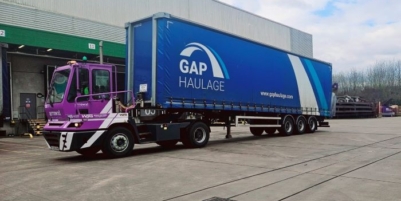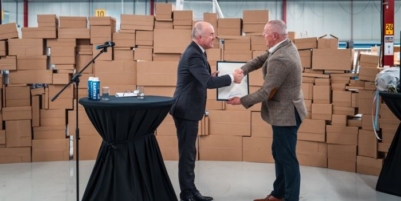-
Nutrivend selects Forterro’s Orderwise to support online expansion and streamline operations - April 11, 2025
-
ARROWXL LAUNCHES AMBITIOUS ZERO WASTE ROADMAP - April 8, 2025
-
THE BCMPA’S NEW CAMPAIGN DRIVES OUTSOURCING SUCCESS IN Q1 - April 7, 2025
-
BLACKOUT TECHNOLOGIES TARGETS TELEMATICS-INTEGRATED MOBILE DEVICE BLOCKING TO COMBAT SMARTPHONE DISTRACTION - April 1, 2025
-
Sparck Technologies awarded Royal designation - March 27, 2025
-
OpenADR Alliance announces first OpenADR 3.0 certified products with EVoke Systems, E.ON Energy and Universal Devices - March 25, 2025
-
Growing fulfilment and contract packer appoints new Managing Director - March 25, 2025
-
When is it time to invest in a WMS? Understanding the key trigger points - March 25, 2025
-
eCapital helps Vantage Recruitment on its journey to financial success - March 24, 2025
-
Hugo Beck Celebrates 70 Years of Packaging Innovation with Open House Events - March 20, 2025
As the pandemic tentatively recedes, and we all begin to dream about a return to normality, challenges still remain for businesses – especially in supply chain and logistics. The world is struggling to return to pre-pandemic output levels, yet the various factors causing the global disruption won’t unwind overnight.
What to do? There is no magic wand to wave, but technology’s ability to increase productivity and efficiency is a secret weapon hiding in plain sight.
To achieve efficient logistics – which involves the likes of managing inventory, shipments and the movement of goods – it is necessary to automate traditional processes. This requires cutting-edge technology. But, for such technology to fulfil its potential, it still needs human capital (i.e. people physically moving and doing things) involved. The problem is that people – literally – have often been neglected by innovation.
What does this mean practically? As digitization has often ignored frontline workers, most logistics operators still use outdated manual workflow and asset management systems. Even where digital solutions are in place, the full benefits are not realized.
To put it simply, the technology your average office worker sees as commonplace – the rapid instant messaging service or the fancy word-processing app – hasn’t had a warehouse logistics equivalent. In industry-speak, integrated workflow management platforms, smart wearables, and AI-powered analytics remain untapped.
A warehouse is a labor-intensive field, where chaos can often only be a short step away. Imagine a technology that seamlessly organized the movement of goods, made processes easy, and made everything optimally efficient.
Workflow management automization solutions, as offered by Arrow Labs with its MIMS product, do just this – and are transforming how companies manage their field resources. This new wave of purpose-built smart technology is making logistics highly efficient, automated, and it’s all flowing through to the bottom line – by increasing companies’ revenues.
Forward-thinking logistics and transport companies adopting these cutting-edge solutions are seeing radical change and great upside. Frontline workers left behind by the digital revolution are now catching up. They are more productive, more self-reliant and instead of being intimidated by a digital revolution that had left them behind – they are empowered. It is a radical and welcome U-turn from digitization being perceived as a threat to frontline jobs. Instead, it is saving those jobs.
What does it look like in practice, at the micro level? It just makes everyday tasks easier and faster. Digital solutions may identify available teams, auto-trigger parts collections, match vehicles and machinery like Uber connects to taxi passengers, or deliver equipment to the production line.
It is all the tasks that happen every day, just more efficiently, but with accurate job execution, and even the warning of bottle necks.
The appeal is wide and benefits many sectors. As a leading provider to warehouses in the UAE, Arrow Labs develops and implements logistics solutions in the oil & gas, maritime and construction sectors, to name just a few.
Scaling also gets easier, as by definition – the larger facilities become – the more challenging execution becomes. But not with digital solutions.
The examples are too numerous to list, but take incoming truck drivers at warehouses. They now receive QR codes via their MIMS app or smart wearable, before arriving at warehouses. The code notes all sorts of details: scheduled arrival time, plate number, type of cargo, etc. Trucks arrive and are processed rapidly. On the other side, unloading teams are ready and unload cargo without delay. Truck turnaround times are vastly reduced, and security is improved as trucks are tracked throughout.
The benefits also extend to ‘last mile’ delivery – i.e. how do companies navigate complex operations and increased demand to still ship deliveries to clients on time, and still control costs?
AI-powered software monitors the crucial indicators: drivers, fleet status, geographic distribution, delivery location and capacity. Algorithms use realtime data to coordinate customers, driver schedules, and delivery routes – and cope with unexpected challenges. The result: a system that can make more deliveries with less delays. That means happy customers, and less stressed drivers.
To tackle, and profit from, the post-pandemic demand surge, logistics operations have to get rid of inefficiencies. Workflow management technology, driven by data, is how to plan for the future.
Digitizing the back office and field operations suits many types of companies, in many sectors, but especially those with large, distributed fleets and asset-heavy operations.
At last, technology has reached logistics, and the great news is two-fold. Not only do these innovations in warehousing, transport and delivery help companies overcome challenging current circumstances, but it won’t break their budgets either.
































